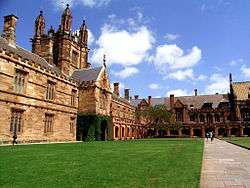Great Hall of the University of Sydney

The Great Hall of the University of Sydney, Australia, is one of the principal structures of the university, with a public interior used for formal ceremonies, conferences, recitals and dinners. The Hall, located in the Main Quadrangle on the Camperdown campus, is a symbol of the university's stately history and an excellent example of Victorian Gothic revival architecture.
History

Designed by Sir Edmund Thomas Blacket (1817–1883), the Great Hall lies at the most northeastern point of the university Quadrangle - dominating the sweeping lawns of University Place, as well as University Avenue, which overlooks Victoria Park. Blacket, who was appointed Colonial Architect of New South Wales from 1849–1854, resigned from his position in 1855 to pursue the design of new buildings for the University - supervising both their development, and construction, until their completion in 1862. Blacket's other notable achievements include the design of St. Paul's College and the alteration of the original construction of St. Andrew's Cathedral in Sydney, from architect James Hume's original design.
The Great Hall was completed in 1859, and represents one of Blacket's finest accomplishments. On July 18, 1859, degrees were first conferred upon graduates by the University in a formal ceremony in the Hall. During 1881–1882, a Forster & Andrews pipe organ was installed, later to be replaced in 1971-72 by the present organ which was manufactured by German builder Rudolf von Beckerath of Hamburg.
Architecture
The Great Hall is recognised as one of the finest examples of the Victorian Gothic revival style of architecture in Australia, in a design that reflects, and harmoniously complements the University Quadrangle of which it forms part.
Westminster model

Westminster Hall, the oldest existing interior of the Palace of Westminster in London, served as Blacket's model for the Great Hall's design. Westminster Hall, erected during the reign of William II in 1097, was later altered during the reign of Richard II between 1394 and 1399. The King commissioned architects Henry Yevele and Hugh Herland to replace the original roof, supported by two pillars, with a more sophisticated hammerbeam roof. Westminster Hall then survived a fire on October 16 1834, which destroyed much of the remaining palace.
The University Design
Like its English counterpart, a wooden, hammerbeam roof is adorned by ten carved angels. The arched design of the roof is supported by six collar beams, and is architecturally reminiscent of such British interiors as those of Stirling Castle, Hampton Court and Etham Castle, all equally typical of Gothic constructions. The marble floor, elevated upon the western side of the hall, mirrors the dais found in Westminster Hall, upon which the throne of King Richard II stood.
The armorial bearings upon the southern side of the Hall, as well as the frame of the Oriel window, have been carved of Caen stone. The walls are otherwise constructed of Sydney sandstone, with a floor of marble. The great beams of the roof are of cedar wood.
External links
Coordinates: 33°53′07″S 151°11′20″E / 33.8854°S 151.1890°E
